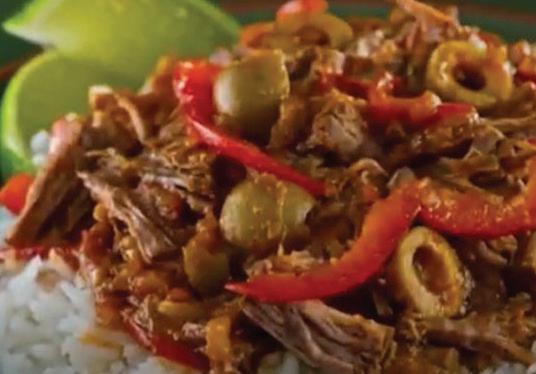
9 minute read
Sabor Latino - Tradiciones de Cuba
By Lázaro Sangroni
ARROZ MORO OR ARROZ CONGRI?
Advertisement
Some Cuban families swear that Congri is traditionally cooked with red beans (or frijoles colorados). They say the same technique using black beans is instead called arroz moro. But my family has always made Congri with black beans, and it’s the same when you order this rice and black beans recipe at Cuban restaurants. So I’m going to stick my neck out and say that Congri is made with black beans! One thing we all agree on is that Congri has is distinct, dark-colored rice that is made by cooking with dried beans.
MOROS Y CRISTIANOS
(or simply moros, moro, arroz moro, or congrí) is a Cuban dish served at virtually every Cuban restaurant. It is the Cuban version of rice and beans, a dish found throughout the Caribbean, the Southern United States, and in Brazil.
What does “Moros y Cristianos” mean?
Moros refers to the black beans and Cristianos to the white rice. The name of the dish is a reference to the African Muslim governance (early 8th century) of the Iberian Peninsula and subsequent Reconquista (15th century) in which Spanish Christians led by wealthy families in the north of Spain forced the Moors from the south of Spain into Africa.

Source: Youtube, Ned2911, United States, and in Brazil. “Historia de la Gastronomia in Cuba
Algunas familias cubanas juran que el Congri se cocina tradicionalmente con frijoles rojos (o frijoles colorados). Dicen que la misma técnica usando frijoles negros se llama en cambio arroz moro. Pero mi familia siempre ha hecho el Congri con frijoles negros, y es lo mismo cuando pides esta receta de arroz y frijoles negros en los restaurantes cubanos. Así que me voy a atrever a decir que el Congri se hace con frijoles negros. Una cosa en la que todos estamos de acuerdo es que el Congri tiene un arroz distinto, de color oscuro, que se hace cocinando con frijoles secos.
Moros y Cristianos
(o simplemente moros, moro, arroz moro o congrí) es un plato cubano que se sirve en prácticamente todos los restaurantes cubanos. Es la versión cubana del arroz con frijoles, un plato que se encuentra en todo el Caribe, el sur de Estados Unidos y en Brasil.
What does “Moros y Cristianos” mean?
Moros se refiere a los frijoles negros y Cristianos al arroz blanco. El nombre del plato hace referencia a la gobernación musulmana africana (principios del siglo VIII) de la Península Ibérica y a la posterior Reconquista (siglo XV), en la que los cristianos españoles liderados por familias ricas del norte de España obligaron a los moros del sur de España a entrar en África

Traditional Cuban Rice Dish
By Lázaro Sangroni

<<< Source: Youtube, CiberCuba, “Platos estrella de la cocina cubana”
Ingredientes
1 pound black beans | 1 libra de frijoles negros
6 cups of water | 6 tazas de agua
2 cups long-grain rice | 2 tazas de arroz de grano largo
5 strips of bacon, cut into pieces | 5 tiras de tocino cortadas en trozos
1 tbsp olive oil | 1 cucharada de aceite de oliva
1 large onion, diced | 1 cebolla grande, picada
1 large red bell pepper, chopped | 1 pimiento rojo grande, picado
3 garlic cloves, minced | 3 dientes de ajo, picados
2 bay leaves | 2 hojas de laurel
4 cups black water from cooking the beans | 4 tazas de agua negra de la cocción de los frijoles
¾ tsp ground cumin | ¾ tsp ground cumin
½ tsp ground oregano | ½ cucharadita de orégano molido
salt & pepper to taste, cilantro bunch, chopped for garnish | sal y pimienta al gusto, manojo de cilantro picado para decorar
Preparation:
This recipe starts with the frijoles. Put the beans and bay leaves in a saucepan and cover with 6 cups of water. Bring to a boil over medium-high heat, then reduce to a simmer. Add water when necessary to keep the beans covered by 1 inch, until just tender. This will take about one hour. Season with a pinch of salt to taste. Now it’s time to have some fun! Fry the bacon and oil in a 6- to 8-quart pot. Cook over medium-low heat until slightly crispy. Add the onion, pepper, garlic, cumin, oregano and stir for about 10 minutes. Add the rice and stir to coat. Add the beans and their liquid, stir well, and add enough water to cover the beans and rice by about 3/4 inch. Bring to a rolling boil over medium-high heat then turn down the heat to maintain a gentle simmer. Cover tightly and do not uncover until the water is absorbed and the rice and beans are both cooked throughout about 20 minutes. Season to taste with salt and pepper. Once done, garnish with cilantro and drizzle with a little olive oil just before serving.
Preparación:
Esta receta comienza con los frijoles. Pon los frijoles y las hojas de laurel en una cacerola y cúbrelos con 6 tazas de agua. Lleva a ebullición a fuego medio-alto y luego reduce a fuego lento. Añade agua cuando sea necesario para mantener los frijoles cubiertos por 1 pulgada, hasta que estén tiernos. Esto llevará aproximadamente una hora. Condimentar con una pizca de sal al gusto. Ahora es el momento de divertirse. Fríe el tocino y el aceite en una olla de 6 a 8 cuartos. Cocina a fuego medio-bajo hasta que esté ligeramente crujiente. Añade la cebolla, el pimiento, el ajo, el comino y el orégano y remueve durante unos 10 minutos. Añadir el arroz y remover para cubrirlo. Añadir las alubias y su líquido, remover bien y añadir suficiente agua para cubrir las alubias y el arroz unos 3/4 de pulgada. Llevar a ebullición a fuego medio-alto y luego bajar el fuego para mantener un hervor suave. Tapar bien y no destapar hasta que el agua se haya absorbido y el arroz y las alubias estén cocidos durante unos 20 minutos. Sazona al gusto con sal y pimienta. Una vez hecho, adornar con cilantro y rociar con un poco de aceite de oliva justo antes de servir.

Source: Blog of, asassyspoon.com/ cuban-style-beefstew-ropa-vieja/
Ropa Vieja
By Mayra Cibeles
From the Spanish term “old clothes”, this is one of Cuba’s most popular and beloved dishes. This dish dates back to the Middle Ages of Spanish Sephardi, a loose adaptation of a dish that remains popular in southern and central Spain. Traditionally it was a way to stretch the leftovers of stews such as "puchero" or "cocido". This dish was later taken to Cuba where the Cubans made it their own.
Del término español “ropa vieja”, es uno de los platos más populares y queridos de Cuba. Este plato se remonta a la Edad Media de los sefardíes españoles, una adaptación suelta de un plato que sigue siendo popular en el sur y el centro de España. Tradicionalmente era una forma de estirar las sobras de guisos como el "puchero" o el "cocido". Este plato fue llevado posteriormente a Cuba, donde los cubanos lo hicieron suyo.
Ingredientes
2 pounds chuck, cut it taller than wider so you get long strands of beef along the grain | 2 libras de carne de ternera, cortada más alta que ancha para obtener largas tiras de carne a lo largo del grano.
1 large yellow onion thinly sliced | 1 cebolla amarilla grande cortada en rodajas finas
1 large green red and yellow bell pepper, thinly sliced | 1 pimiento rojo y amarillo grande, en rodajas finas
4 cloves garlic minced | 4 dientes de ajo picados
2 teaspoons dried oregano | 2 cucharaditas de orégano seco
2 teaspoons ground cumin | 2 cucharaditas de comino molido
2 teaspoons sweet paprika | 2 cucharaditas de pimentón dulce
1 teaspoon smoked paprika | 1 cucharadita de pimentón ahumado
⅛ teaspoon ground allspice | ⅛ cucharadita de pimienta de Jamaica molida
⅛ teaspoon ground cloves | ⅛ de cucharadita de clavo de olor molido
2 teaspoons kosher salt | 2 cucharaditas de sal en grano
1/2 teaspoon freshly ground black pepper | 1/2 cucharadita de pimienta negra recién molida
1/2 cup dry white wine | 1/2 taza de vino blanco seco
1 cup chicken broth | 1 taza de caldo de pollo
1 16 ounce can crushed tomatoes | 1 lata de 16 onzas de tomates triturados
1 6 ounce can tomato paste | lata de 6 onzas de pasta de tomate
2 bay leaves | 2 hojas de laurel
1 large carrot cut in half | 1 zanahoria grande cortada por la mitad
1 large stalk celery cut in half | 1 tallo grande de apio cortado por la mitad
1 cup naturals Green Olives rinsed and drained | 1 taza de aceitunas verdes naturals enjuagadas y escurridas
1/2 cup thinly sliced Roasted Red Peppers drained | ½ taza de pimientos rojos asados en rodajas finas, escurridos
⅟4 cup pimientos drained | ⅟4 de taza de pimientos escurridos
2 tablespoons capers rinsed and drained | 2 cucharadas de Alcaparras enjuagadas y escurridas
⅓ cup chopped fresh parsley | ⅓ de taza de perejil fresco picado
Preparation:
1. Pat the beef dry and sprinkle with salt and freshly ground black pepper.
2. Heat a little oil in a Dutch oven over high heat. Once very hot add the beef and brown generously on all sides. Transfer the beef to a plate.
3. Add the sliced vegetables to the pot and cook over medium heat for 15-20 minutes until caramelized. Add the garlic and spices and cook for another minute. Add the white wine and bring it to a rapid boil, deglazing the bottom of the pan.
4. Add the broth, crushed tomatoes, tomato paste and bay leaves. Simmer for 5 minutes.
5. Return the roast to the pot along with the pieces of carrots and celery. Bring to a boil, reduce the heat to low, cover and simmer for 3-4 hours or until the beef is fork tender and falls apart easily. Discard the celery, carrots and bay leaves.
6. Transfer the beef to a plate and shred it.
7. Stir in the olives, roasted red peppers, capers and pimientos. Simmer uncovered to thicken the sauce for 30 minutes. Stir in the parsley and add salt and pepper to taste.

1. Secar la carne con palmaditas y espolvorear con sal y pimienta negra recién molida.
2. Calienta un poco de aceite en un horno holandés a fuego alto. Cuando esté bien caliente, añada la carne y dórela generosamente por todos los lados. Pasar la carne a un plato.
3. Añadir las verduras cortadas a la olla y cocinar a fuego medio durante 15-20 minutos hasta que se caramelicen. Añade el ajo y las especias y cocina un minuto más. Añada el vino blanco y llévelo a un hervor rápido, desglasando el fondo de la olla.
4. Añadir el caldo, los tomates triturados, la pasta de tomate y las hojas de laurel. Cocinar a fuego lento durante 5 minutos.
5. Volver a poner el asado en la olla junto con los trozos de zanahoria y apio. Llevar a ebullición, reducir el fuego a bajo, tapar y cocinar a fuego lento durante 3-4 horas o hasta que la carne esté tierna y se deshaga fácilmente. Deseche el apio, las zanahorias y las hojas de laurel.
6. Pasar la carne a un plato y desmenuzarla.
7. Incorporar las aceitunas, los pimientos rojos asados, las alcaparras y los pimientos. Cocer a fuego lento sin tapar para que la salsa se espese durante 30 minutos. Incorporar el perejil y añadir sal y pimienta al gusto.
| Read this article in the magazine | page 24-25










